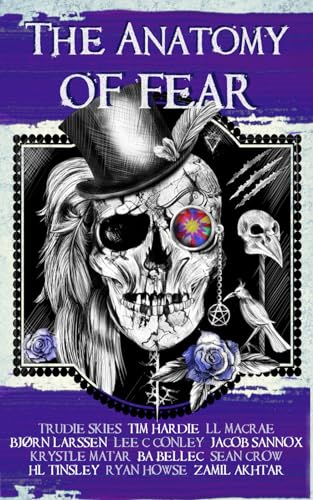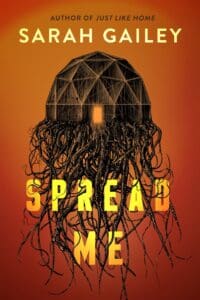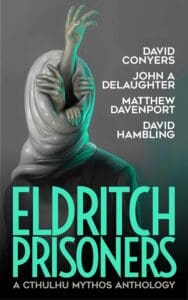
Tis the Season to be Terrified, Fa-la-la-la-la la-la-la-arggggghhh
Synopsis
‘The skull bell tolled, but only Lena heard it.’ – L.L. MacRae (Bone) Fear is universal – a shared human experience that provokes awe, curiosity and terror. It feeds our anxieties, elevating our heartbeats and driving the instinct to survive. But what are we afraid of – and why? Each story in this anthology seeks to answer that question, blurring the boundaries between horror and fantasy fiction. A collection of tales written to evoke feelings of discomfort and despair, fear and fascination in equal measure – inspired by the different parts of our own fragile, breakable, all-too-mortal bodies. Ranging from dark, blood-stained gothic streets to haunting visions of otherworldly beings to drug-fuelled paranoia trips that twist reality, The Anatomy of Fear is an exploration of the dark realms of the mind.
Review
There’s nothing like surrounding yourself with death to feel alive.
Depending on the definition you read, fantasy, even of the dark or grimdark kind, is very different from horror. The former generally requires a secondary world and focuses on the quest of the protagonist to achieve something within it, whereas horror is more about the terror intruding on the mundane, and how the victim copes with their world falling apart as a result. And yes, I did Google that, what’s your problem?
But while they might be different, horror is always creeping into fantasy, and nerds like me who lurk on the borders of both in their reading tastes absolutely love to see it. So when an anthology like this comes along – a bunch of acclaimed and award-winning indie fantasy authors getting their teeth stuck into fantasy horror, or in some cases just outright horror – the idea sounds more appealing than a month in a wine cellar.
But while the idea is great, the execution – blimey. These authors have dug deep to produce genuinely brilliant work, edited by editor supremo Sarah Chorn, with the unusual result of an anthology with absolutely no duds.
The basic premise of The Anatomy of Fear is that this is an exploration of fear; with the secondary idea that each story is based around a different part of the body (toes, blood, neck etc, you probably got the concept without me needing to name the parts, didn’t you?). But while both these conceits are pretty neat, what I think really makes this anthology stand out is the admirably diverse genre approaches to the mission at hand, which give this anthology more layers than a forgetful chef’s lasagne recipe.
Some authors, for example, focus more on the horror than the fantasy, clearly having fun playing in a different genre. Perhaps the most successful of these is Trudie Skies’ glorious opener Blood, a classic hammer horror vampire tale – a monster hunter arrives at a town where people have been seemingly dying from vampire attacks, and our hero attends a ball at a nearby castle with a suspicious baroness who paints in blood (immediate red flag that, literally). What is great about this tale is that Skies throws in a third genre – murder mystery – and as the guests drop and the vampire carnage grows, half the fun is spotting the clues and the red herrings. One of the best starts to an anthology you’re likely to see, with a wickedly tongue-in-cheek (or perhaps fang in neck) flourish of an ending.
Another example of outright horror is Zamil Akhtar’s Skin, which combines gruesomely and gleefully described body horror with a contemporary tale of someone seeking therapy to address his phobias and suppressed childhood memories, which rapidly deteriorates into a memorably hellish tale of cosmic horror. It is impressive how quickly this tale goes from mystery to outright hellscape carnage; Akhtar is having fun and it shows.
Meanwhile, in the body horror/demonic/cosmic mould, Ryan Howse brings us a despicably nightmarish tale of a woman who prays to a number of god-like entities for favours, with predictably terrible results; the imagination on display here to describe the myriad forces at work is as impressive as the horrific things these forces will do to the body. This tale is grimmer than The Brothers Grimm at a funeral wake.
Then there’s the tales in this collection where the authors dig into their fantasy roots to create a secondary fantasy world and infuse it with the kind of horror to keep you up at night screaming into the void (sorry I meant praising your daytime reading choices, delete as accurate). One example of this is Tim Hardie’s tale Ears. Here we have a province whose previously lavish society and economy has been decimated by the arrival of nightmarish creatures the Whisperers, who control demonic hounds and have power over those who can hear them. This leads to some nice Birdbox-style touches – instead of walking round blind, people travel in soundproof trains – but it’s the revelation as to the true nature of their powers which is genuinely disturbing, and the Whisperers’ plans are so relentlessly evil that you’ll have to binge-watch stand-up comedy for an hour to get the pain of the denouement out of your head.
Speaking of evil, we have Mind by Sean Crow, which is one of my standouts. Crow gives us a fantasy land recovering from a devastating war with an enemy who uses nightmarish creatures – including the undead and werewolf variants – on the battlefield. Our protagonist is recruited by a hunter to hunt down a particularly nasty example and his crew. The blend of military horror and The Witcher-style hunting makes this the kind of story begging to be turned into a novel, and the character building of our stalwart survivor combined with the growing dread as his hunting party are picked off one by one by the mind-controlling enemy make this a real gem.
Another memorable example of worldbuilding comes from H L Tinsley, who gives us a world where powerful mages have been hunted down and executed, and buried without the rites to set them free, with predictably dangerous consequences for the humans engaged in this brutal crackdown. Of all the varied and brilliant prose styles on display in this anthology, Tinsley might be one that grabbed me by the throat the most, as every other sentence here is a glorious whiplash to the throat, her story full of more memorable one-liners than a day at a comedy festival, albeit of the poetically grim kind. This tale burns slow but explodes into an incredible finale that I imagined in my head as a billion-dollar dark Hollywood epic.
Particular bonus points for invention in this anthology here should go to Krystle Matar and Teeth, who does the admirably ballsy move of setting her story inside the fantasy word she has already created for her grimdark fantasy series The Tainted Dominion. While this is no doubt a nice treat for her existing fans, she is careful to do so gently, not making it confusing for those unfamiliar with her work. But while it’s not immediately obvious where the horror comes in this immediately engrossing grimdark world, the beauty of this tale – in which a son and daughter must contend with their abusive father – is how Matar dripfeeds the slow, seeping psychological horror in with the trauma of tragedy, represented by the memorably nightmarish image of baby teeth in someone’s pocket. The slow-burning claustrophobia of the suppressed trauma in the tale grows on you with Matar’s thoughtful, powerful prose until the inevitable climatic showdown. It’s a marvellously written tale that has shot Matar’s work right up my TBR.
Speaking of an abusive father, with Bones, LL MacRae gives us a standard fantasy setting – villages beset by nightmarish creatures, and the head of a household who hunts them for his village – and narrows the focus to the family home and the family trauma of an abusive husband and father. The way MacRae weaves in the magical elements with the trauma at the heart of it and the growing sense of dread is, ultimately, resplendently expectation-defying, giving us a fascinating examination of how fear can be overcome and power can be reclaimed. It’s a poetic, haunting take, markedly different from the rest, and a real spotlight for MacRae’s already seriously acclaimed brand of writing.
I also have to mention the token “moral dilemma” tale that any good anthology needs – the remarkable Liver by Jacob Sannox. Here we get a suspiciously utopian fantasy city where life is great, but what lies underneath this creepily perfect surface? Sannox gives us a deliciously fiendish moral quandary (well maybe not that fiendish, I might just be part evil) and wraps it up in a disgustingly, gloriously gruesome horror flourish that might make you think twice in the future should you ever come across a certain well-known delicacy.
If I’ve not covered all the tales in my feverish summaries of the damned above (anthology reviews are pretty knackering to write, not going to lie) then please know that each and every one is worth the read, this collection defined by its consistent and unrelenting excellence. I’ve read many a horror anthology in my time, and it’s a real pleasure to find one treated with such reverence and playfulness with the potential of not one but two genres. Do yourself a favour: find an armchair, put all thoughts of hope and daylight out of your head, and drown yourself in the cream of fantasy authors doing their best to break your sanity. This is mission achieved and it MUST be read. As H L Tinsley warned at the start of this review, there’s nothing like surrounding yourself with death to feel alive.







Leave a Reply